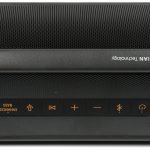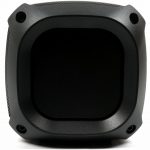Oh my God, again howler cubes?! Well, it won't be that bad this time. Promised! But always nice in turn, because there are not one, there are also not two, but three siblings in the test. Two of them with luminous RGB eyes, only the smallest speaker has to do without the LED Christmas simulation and then look comparatively gloomy. By the way, this time I will focus on audio measurements to question what the mysterious Meridian technology is all about.
But before I start with the details, I'll just quickly summarize the things that are the same for all three candidates. similar. The scope of delivery offers at least no surprises besides loudspeaker, manual and charging option. While the PK7 is at least still a plug-in power supply, the PK5 and the PK3 are only supplied with a USB-C charging cable. However, you can't find more accessories. But it's enough, too.
The question of whether it is not quite dense could also be answered with a "but", because the PK7 and the PK5 are at least splash-proof according to IPX5 and should be able to withstand the swell of water from the disgruntled balcony upper tenant at an open-air party. The first dark PK3 turns out to be a funny water rat, because with IPX7 you could even safely sink it in a sangria bucket. The thing is waterproof and is therefore more suitable for bathroom, shower and pool.
And RGB probably just had to be The PK7 has two illuminated membranes and two luminous stripes in the front, with the PK5 only the membranes glow. The luminous effects follow the music as desired, can also be adjusted somewhat variable and who wants to know more: below I have embedded the manual of the PK7, which applies equally to all three devices.
But there is not only something for the eyes. All three have the apt-X HD codec, which at least from the data sheet is significantly higher than what the three speakers could physically reproduce – as long as it also supports the source. Multi-Bluetooth is also not so self-evident and so two devices can connect to a speaker at the same time. Multi-Play then connects two of the loudspeakers for double party sound. Tricky, but nice.
Since a microphone is also installed in all loudspeakers, you can e.g. Google's voice assistants or Apple – depending on the connected smartphone. And then there are the sound players, who come into play a little more differently per device, so I moved it to the next page in the test area.
LG PK7 in Unboxing
Let's start with LG's upper class, the PK7. Most of the functions have also been donated to this part, whereby the housing construction meets the set claim to be a party speaker everywhere. The feet decouple it quite skilfully from the installation site and also keep sand or earth crumbs away.
The choice of materials is fine, because the obviously quite impact-resistant plastic body and the stands make a solid impression. The screwing with hexagonal screws instead of a profane bonding also gives a little hope for stability here. Multi-point and dual-play are on board, charging is done via the supplied plug-in power supply. Unfortunately, you don't have an intelligent quick-button function and also lack the optional use as a power bank for the hungry smartphone. It's a pity, because that's what almost all the larger portable speakers now offer.
With two active loudspeaker chassis per channel and the two passive subwoofers on the sides, the placement is also at the limit. More just doesn't fit in.
The battery LED to the left of the control panel, as well as the two LEDs in the left buttons, fulfil several functions and it is definitely recommended to take a look at the manual. In addition to the well-known buttons for on/off, Bluetooth, volume and player control, you will also find the microphone button for starting the voice assistant or Light control. The two buttons for digital sound management can be selected independently, I will go into the results in more detail later.
With the splash-proof connections in a trough at the back you will find the plug-in socket for the charger, the analog 3.5 mm jack input, a reset button and the button for connecting another speaker for the common play. In practice, this works quite well, but requires compatible devices.
The indication of the output line is somewhat vague, because it is neither 40 watts of sine nor real 40 watts of RMS. This is not technically possible. Purely sound pressure-related values such as P.M.P.O. (Peak Music Power Output) should then at least be marked as such.
LG PK5 in Unboxing
As with the PK7, the housing construction certainly meets the set claim to be a party speaker everywhere. The feet also skilfully decouple the device from the installation site and also keep the already mentioned sand or earth crumbs away. Otherwise, the praise for the screws and the general feel is also valid here. As with the PK7, the perforated metal is relatively thick and therefore rather insensitive. The LED garland lacks the two longitudinal stripes, the rest looks similar.
Multi-point and dual-play are on board, charging is done via USB-C and a short cable supplied. This also prevents an intelligent quick-button function and also lacks the optional use as a power bank for the hungry smartphone. It's a pity, because that's what almost all the larger portable speakers now offer. The PK5 uses one broadband speaker chassis per channel and one passive subwoofer on the sides.
The battery LED to the left of the control panel, as well as the two LEDs in the left buttons, as with the PK7, also meet several functions, the manual is also the best guide here. In addition to the well-known buttons for on/off, Bluetooth, volume and player control, you will also find the microphone button for starting the voice assistant or Light control. The two buttons for digital sound management can of course also be selected independently for the PK5.
With the splash-proof connections in a trough at the back, you will find the USB-C jack for the charging cable, the analog 3.5 mm jack input, a reset button and the button for connecting another speaker for the common play. In practice, this works quite well here, but requires compatible devices. However, the cover is fingernail-murdering, which also applies to the other two subjects.
The indication of the output line is also somewhat questionable here and it looks again very strongly e.g. P.M.P.O. (Peak Music Power Output). Advertising effective, but annoying for all those who know where Bartel gets the must.
LG PK3 in Unboxing
The small PK3 is in fact the deep-sea diver among the other two paddling pool visitors. A courageous throw in the laboratory bucket with wiping water went smoothly, so fits. Who can do without the luminous party LED garland – all the better.
Multi-Point is unfortunately missing here, but dual play is at least available. Charging is done via USB-C and a short cable supplied. Charging for almost 5 hours is a bit annoying, but it doesn't seem to matter if you're using USB 2.0, 3.0 or 3.1. If you want to be safe, take a power bank to the balcony if the night should be extra long.
The battery LED to the left of the control panel, as well as the two LEDs in the left buttons, like the other two test objects, meet several functions, RTFM helps as always. In addition to the well-known buttons for on/off, Bluetooth, volume and player control, you can also find the bass boost for digital sound management, but the rest is missing here.
The splash-proof connectors in a trough at the back include the USB-C charging port, the analog 3.5 mm jack input and a reset button. The cover sits firmly like a rusted screw of a World War II tank, probably also because of IPX7.
I give myself the sentence with the output power, we have probably all understood it by now. From a purely comparative point of view, 10 watts of RMS would probably be better. But we don't want to start with estimates. It's relatively noisy, yes.
Technical data and manuals
I have now summarized all the data in tabular form, which is the manufacturer's data. You have to do this, e.g. in the output power, but with a little caution. Watt information without marking the measuring method or the reference value is always somewhat uncool. Be that as it may…
| Technical data: |
|||
|---|---|---|---|
| Model: | LG PK7 | LG PK5 | LG PK 3 |
| Output | 40/30 Watts (power operation, battery) | 20 watts | 16 watts |
| Output: | 2.0 Stereo | 2.0 Stereo | 2.0 Stereo |
| Bluetooth: | APT-X HD, APT-X, SBC, AAC | APT-X HD, APT-X, SBC, AAC | APT-X HD, APT-X, SBC, AAC |
| Specifics: | Multi-Point, Dual-Play | Multi-Point, Dual-Play | Dual-play |
| Dsp: |
Standard, Clear Vocal, Enhanced Bass | Standard, Clear Vocal, Enhanced Bass | Standard, Enhanced Bass |
| Lighting: | Multicolor Lighting, Mood Lighting | Multicolor Lighting | No |
| Status LED: | BT, Power on, Battery, EQ, Dual Play | BT, Power on, Battery, EQ, Dual Play | BT, Power on, Battery |
| Feed: | Bluetooth, 3.5mm jack | Bluetooth, 3.5mm jack | Bluetooth, 3.5mm jack |
| Class: | IPX5 | IPX5 | IPX7 |
| Battery: | 7.4V 5200mAh | 7.4V 2600mAh | 3.7V 4200mAh |
| Runtime: | Up to 20 hours | Up to 15 hours | Eel 10 hours |
| Loading: | Eel 3.5 hours | Eel 4 hours | Eel 5 hours |
| Charge: | Plug power supply | USB-C | USB-C |
| Dimensions: | 32.0 x 16.7 x 15.2 cm | 22.0 x 12.9 x 11.9 cm | 18.2 x 8.2 x 8.2 cm |
| Weight: | Eel 2.9 kg | 1.2 kg | 0.7 kilos |
| Price: | from approx. 130 euros | from approx. 100 Euro | from approx. 90 Euro |
Here is the data sheet for the very detailed. For the smaller versions, it is easy to think away from the missing functions:
Handbuch LG PK7























































Kommentieren